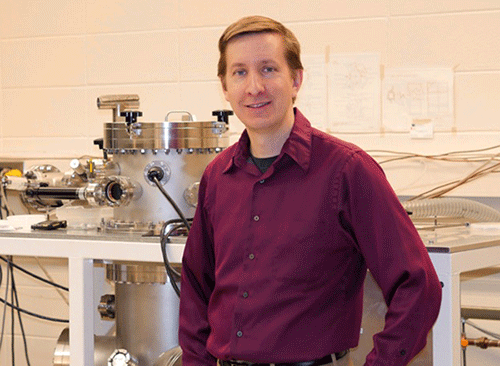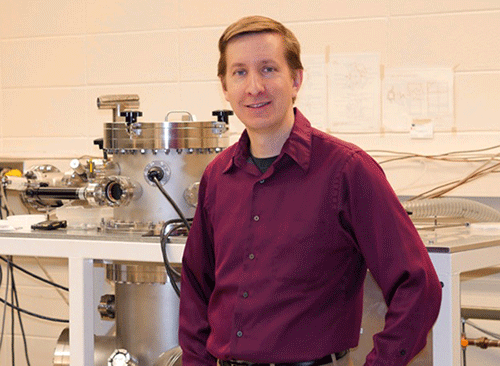Q&A: Building Quantum Computers with Superconductors
Circuits have always captivated Britton Plourde. As a kid he designed and built model airplanes, a hobby that required wiring together numerous electronic parts. In graduate school he turned to fabricating even smaller and more complex circuits made from micrometer-sized superconducting materials. Today Plourde heads a group at Syracuse University in New York that is trying to build superconducting elements for a quantum computer. To learn more, Physics met up with Plourde at his lab at Syracuse.
–Katherine Wright
What are you working on at the moment?
My focus is on quantum bits (qubits): How to make them, how to make them better, and how to increase the qubit lifetime—the time it takes the qubit to decay from a quantum superposition of states to a classical state. I’m also trying to understand ways to make multiple qubits interact with each other, to do things like generate entangled states between several qubits.
Your main interest is superconducting qubits. What are they?
They are microfabricated electrical circuits that contain superconducting elements, and they behave like artificial atoms with discrete energy levels. Two different electrical excitations in the circuit correspond to the two states of the qubit.
There are many ways to make qubits. Why have you focused on using superconductors?
Right before I started my postdoc at UC Berkeley in 2000, a group in Japan had made the very first superconducting qubit. At the time, superconducting circuits seemed like an intriguing research direction, but they only had lifetimes of a nanosecond or so—nowhere close to being practical. But superconducting elements can, in principle, be integrated into a large processor using techniques similar to those developed by the semiconductor industry, which could allow for the rapid manufacture of billions of superconducting circuits. We wanted to leverage the same technology for quantum computers. But first we had to figure out if we could make robust quantum states from superconducting circuits. Back in 2000 that was a big if.
And now?
Right now we’re at a level where it’s feasible to build a small-scale quantum processor with a superconducting circuit. It’s possible to make systems with ten qubits, maybe a little bit beyond that. More importantly, qubit lifetimes have improved by 5 orders of magnitude since 2000. Also there have been key steps towards implementing circuits and control techniques that can correct for quantum errors, a critical element for building a quantum computer. It’s exciting!
What calculations have been run on superconducting quantum computers?
There have been several initial demonstrations of quantum algorithms, including factoring 15 into 5 and 3. The factoring algorithm was one of the original algorithms that kicked off research into quantum computers because there is no known efficient classical algorithm that can factor large numbers into primes. As the number gets really big, the time for the computation blows up rapidly. If a number contained 2000 bits—600 digits—the time needed to factor it would be longer than the age of the Universe. A quantum computer could factor such a large number in roughly a day, but the computer would need well over a million qubits, amongst other things, so we’re a little ways off!
Are there other things a quantum computer could do?
There is currently a lot of interest in quantum simulation—using a quantum computer to simulate another quantum system, such as complex molecules, which are difficult to simulate numerically on a classical computer. This wouldn’t need anywhere near a million qubits, but could be done with say tens or hundreds. [Simulation] will probably be the first breakthrough for quantum processors in which they perform faster than a classical approach.
Do you think we’ll ever have personal quantum computers?
No. There is not going to be a day when everybody has a quantum computer on their desks. And quantum computers will not be able to solve all problems faster than a classical computer—that’s a common misconception. There are many problems where a quantum computer would be slower, or simply wouldn’t make sense to use. You wouldn’t run a spreadsheet or write your term paper for history class on a quantum computer.
Why is 2016 a great time to be working on quantum computing?
The field is at this exciting intersection between fundamental physics and cutting-edge technology. We’re now able to engineer artificial quantum systems and to study fundamental properties of quantum mechanics in big systems that we can control. That’s neat. And several companies are trying to build superconducting quantum computers. Someone getting an advanced degree in this area certainly has good opportunities.
Know a physicist with a knack for explaining his or her research to others? Write to physics@aps.org. All interviews are edited for brevity and clarity.





